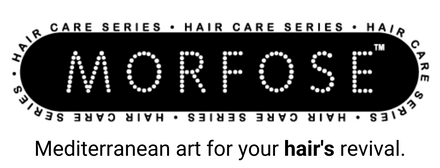Low vs High Porosity Hair A Practical Guide
Posted by JENNIFER C.
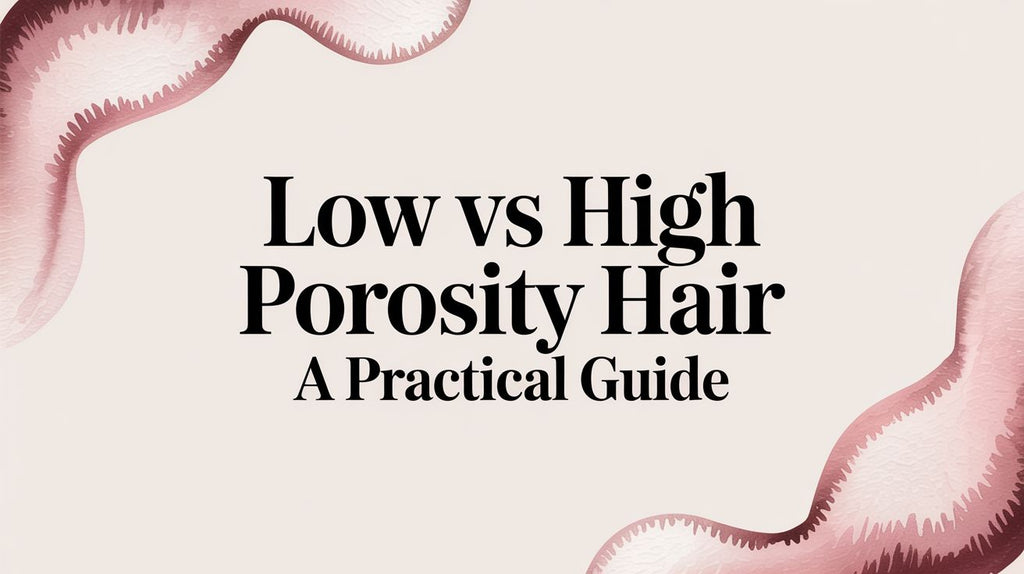
When you get down to it, the real difference between low vs high porosity hair is all about how it handles moisture—both getting it in and keeping it there.
Low porosity hair has a cuticle layer that's clamped down tight, making it tough for water and products to penetrate. On the flip side, high porosity hair has a more open cuticle structure, so it soaks up moisture like a sponge but, unfortunately, loses it just as quickly. Grasping this simple concept is the first real step toward finding products and a routine that finally work for your hair, not against it.
Understanding Hair Porosity and Why It Matters
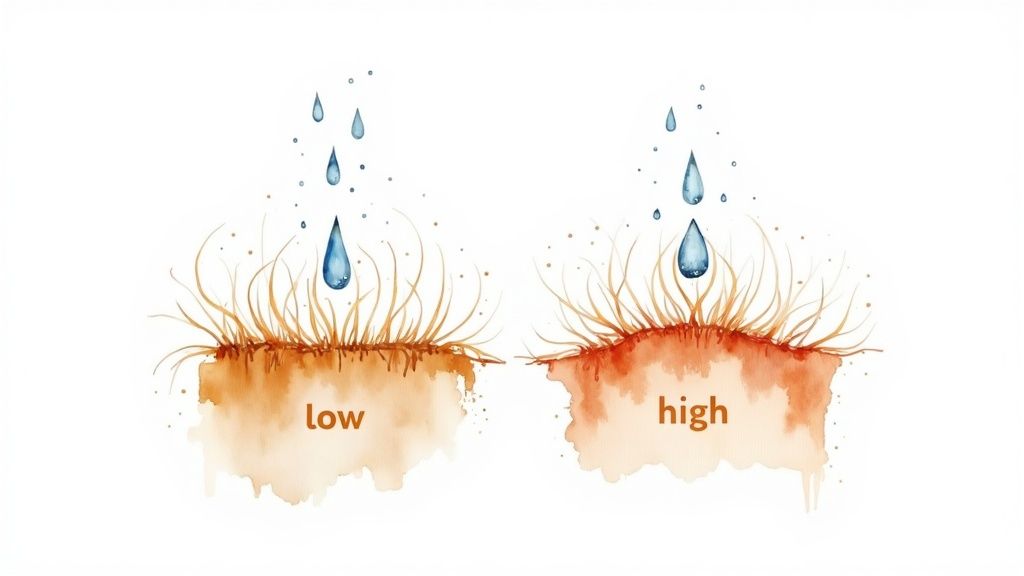
Simply put, hair porosity is a measure of your hair's ability to absorb and hold on to moisture, whether that's water, oils, or conditioners. This is all dictated by the hair's outer layer, the cuticle, which is made up of tiny overlapping scales. Honestly, this single trait probably has a bigger impact on your hair's day-to-day health and behavior than your curl pattern or whether it's fine or coarse.
A great way to visualize it is to think of the hair cuticle like the shingles on a roof. For low porosity hair, those shingles are lying perfectly flat and sealed tight. This creates a strong barrier that water has a hard time getting through. With high porosity hair, the shingles are raised and spaced out, leaving plenty of gaps for moisture to flood in... and right back out.
Key Differences at a Glance
Figuring out your porosity type is the game-changer you need to build a routine that actually makes sense. While both hair types can feel dry, the reasons why are polar opposites—and so are the solutions. This explains why a "miracle" product for your friend might leave your hair a greasy, limp mess or a frizzy, brittle one.
The beauty industry is catching on, too. The market for products designed specifically for different porosities is expected to hit over USD 1.12 billion by 2033, which just goes to show how much people are shifting toward smarter, personalized hair care.
| Characteristic | Low Porosity Hair | High Porosity Hair |
|---|---|---|
| Cuticle Structure | Tightly packed and flat | Raised with gaps and spaces |
| Moisture Absorption | Very slow; water beads up | Soaks up moisture instantly |
| Drying Time | Takes a very long time to air dry | Air dries surprisingly fast |
| Product Feel | Products tend to sit on the surface | Products seem to disappear into the hair |
| Main Challenge | Getting moisture into the strand | Keeping moisture from escaping |
Key Takeaway: Stop obsessing over your curl pattern and start paying attention to your porosity. It’s what truly dictates which ingredients will be your hair’s best friends and which will just cause buildup or dryness. This is the real foundation of a successful hair care plan.
Once you understand your hair’s unique structure, you can stop the expensive guesswork. You can finally pick products that address the root of your hair problems. To dive deeper, check out our guide on the science of hair. This is how you empower yourself to give your hair exactly what it’s been crying out for.
How to Figure Out Your Hair Porosity
Before you can build a hair care routine that actually works, you have to know what you’re working with. Figuring out your hair’s porosity is that critical first step, but there's a lot of confusing advice out there. The most important thing? You have to test your hair when it's completely clean and free of any product.
Product residue, natural oils, and even silicones can create a film on your hair shaft. This coating totally messes with the results because it prevents water from getting to your cuticle like it normally would. To get a true reading, give your hair a good wash with a clarifying shampoo and skip the conditioner or any leave-ins just this once.
If you suspect you have a lot of buildup, it's worth learning how to detox your hair for a healthier look first. Once your hair is squeaky clean and has air-dried, you’re ready to get some real answers.
The Float Test
This is probably the test you’ve seen everywhere, and for good reason—it’s simple and gives a great visual. It’s a straightforward way to see how your hair interacts with water on its own.
Here’s what you do:
- Grab one or two strands of clean, dry hair from your comb or brush.
- Drop them into a clear glass of room-temperature water.
- Now, just watch what happens for the next 2-4 minutes.
Reading the Results:
- It floats: If your hair is still floating on the surface after a few minutes, you almost certainly have low porosity hair. Its tightly packed cuticle is repelling the water.
- It sinks fast: Did the hair drop straight to the bottom? That's a classic sign of high porosity hair. The gaps in the cuticle let water flood in, weighing it down.
- It hangs out in the middle: If the strand just hovers somewhere in the middle of the glass, you're likely looking at medium (or normal) porosity hair.
The Spray Bottle Test
This test gives you a real-time look at how your hair first responds to moisture. It’s a fantastic clue for predicting how your hair will handle styling products when you apply them.
Just take a small section of your clean, dry hair and spritz it lightly with water from a spray bottle. Pay close attention to what happens right away.
What to Look For: See little beads of water sitting on top of your hair? That’s a tell-tale sign of low porosity. On the flip side, if your hair seems to drink up the water instantly with no beading at all, you’ve got high porosity hair.
The Slip-and-Slide Test
This is a more hands-on test that lets you physically feel the state of your hair's cuticle. It’s a great way to double-check what you learned from the other tests.
Take a single strand of hair and pinch it between your thumb and forefinger. Slide your fingers up the hair shaft, moving from the end toward your scalp. How does it feel?
If your fingers glide smoothly without any friction, your cuticles are lying flat and closed, which points to low porosity. But if you feel a bumpy or rough texture as you slide up, it means your cuticles are raised and open—a clear indicator of high porosity. That rough feeling is exactly why high porosity hair tends to get tangled and frizzy so easily.
Comparing Low Porosity and High Porosity Hair
Figuring out the difference between low and high porosity hair is like finally getting the instruction manual for your own head. While both types can feel dry, the root cause is completely different, which means they need entirely separate game plans to look and feel their best.
The whole story comes down to your hair's cuticle—the protective outer layer. Think of low porosity hair as having shingles that are nailed down tight. They form a solid, protective barrier. High porosity hair, on the other hand, has shingles that are lifted or missing, leaving the inside of the hair shaft vulnerable.
This single structural difference is behind everything, from how your hair feels when it’s wet to how it behaves with your go-to stylers.
The Battle of Absorption and Retention
The biggest and most obvious difference you’ll notice is how your hair handles water. It’s a dead giveaway.
Low porosity hair is stubborn about letting moisture in. You’ll see water bead up on your strands, and it can feel like it takes forever to get your hair fully soaked in the shower. But here's the upside: once that moisture finally gets in, the tightly sealed cuticle locks it down.
High porosity hair is the total opposite. It’s thirsty and drinks up water and products instantly, like a sponge. The catch? Those open cuticles that let moisture in also let it right back out, just as fast. This is why high porosity hair often gets stuck in a frustrating cycle of dryness and frizz.
Key Differentiator: Low porosity hair’s problem is absorption—getting moisture to penetrate. High porosity hair’s problem is retention—keeping that moisture from escaping.
Drying Time and Product Buildup
How long your hair takes to dry tells you a lot. Because low porosity hair clings to every drop of water it absorbs, it can take hours, sometimes even a whole day, to air-dry.
High porosity hair, however, often air-dries incredibly fast. While that might sound like a plus, it’s usually a red flag that it’s not holding onto the hydration it so desperately needs.
This contrast also shows up when you apply products:
- Low Porosity: Famous for product buildup. Heavy butters and thick creams just sit on top of the hair shaft, making it feel greasy, heavy, and lifeless.
- High Porosity: Soaks up everything you put on it. It can actually handle richer creams and oils because it needs them to fill in the gaps and seal the cuticle.
If you're trying to figure out where your hair lands, a few simple at-home tests can give you the answer. This graphic breaks down the most common methods.
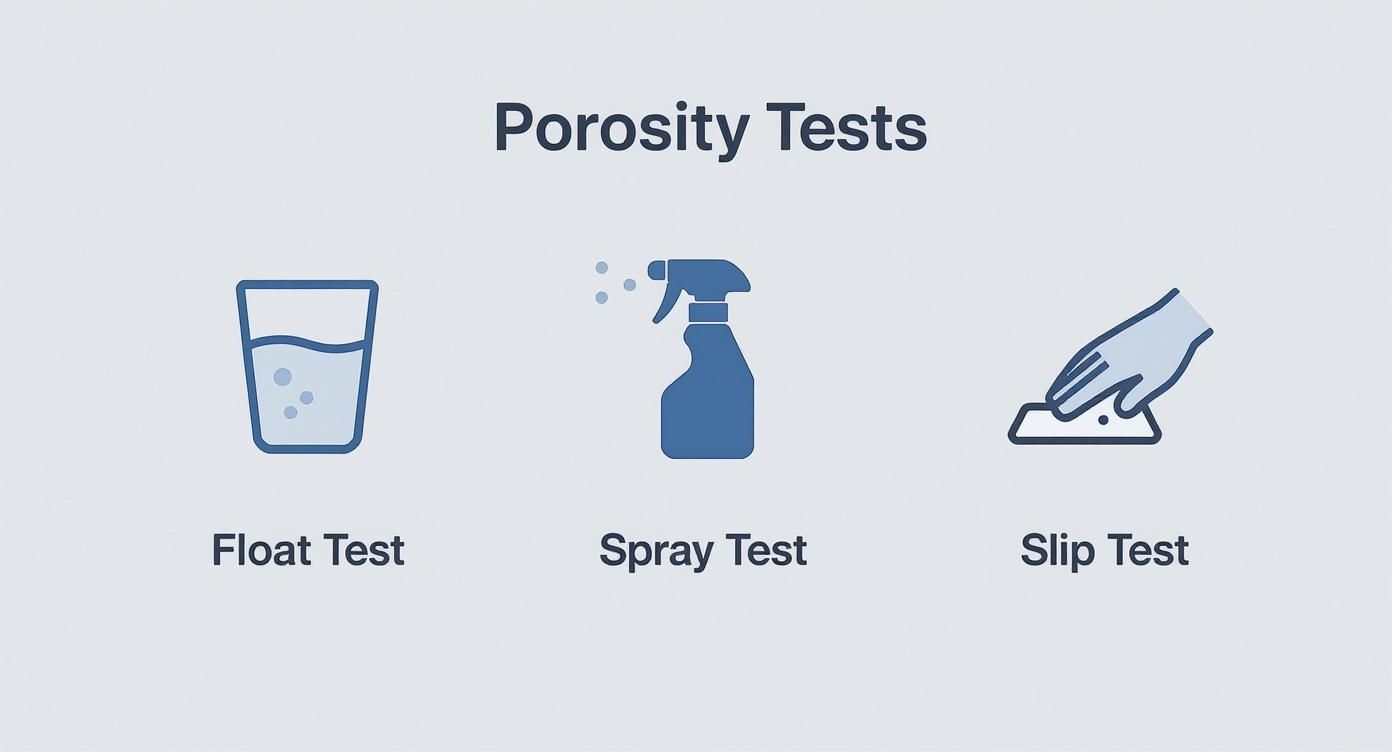
As you can see, just paying attention to how your hair acts around water or how it feels between your fingers can tell you a huge amount about what’s going on at a microscopic level.
Protein Sensitivity and Elasticity
Protein treatments get a lot of hype for repairing damage, but whether they help or hurt really depends on your porosity. High porosity hair typically loves protein. Since this hair type often has gaps from chemical or heat damage, protein treatments act like spackle, temporarily patching the holes to add strength and reduce breakage.
Low porosity hair, on the other hand, is often protein-sensitive. Its cuticle is already compact and strong, so adding extra protein can make the hair feel rigid, brittle, and straw-like. The protein molecules can't get in, so they build up on the outside, causing what many call "protein overload."
To make things even clearer, here’s a quick rundown of the key differences between the two.
Low Porosity vs High Porosity At a Glance
This table sums up the core traits, challenges, and needs of each hair type so you can see them side-by-side.
| Characteristic | Low Porosity Hair | High Porosity Hair |
|---|---|---|
| Cuticle Layer | Tightly sealed and flat | Open, raised, and gapped |
| Moisture Absorption | Slow to absorb; water beads up | Absorbs moisture instantly |
| Moisture Retention | Excellent; holds moisture for a long time | Poor; loses moisture quickly |
| Air Drying Time | Very long | Very fast |
| Product Feel | Products sit on top, causing buildup | Products are absorbed quickly |
| Protein Response | Often sensitive; can become stiff | Generally beneficial; strengthens strands |
| Common Challenges | Product buildup, greasy feel, stiffness | Frizz, dryness, breakage, tangles |
Once you can spot these behaviors in your own hair, everything changes. You can stop fighting an uphill battle and start giving your hair exactly what it’s been asking for.
Building a Routine for Low Porosity Hair
When you have low porosity hair, the game is all about getting moisture in without weighing your hair down. The secret? Lightweight, water-based products are your best friend because their smaller molecules can actually get past that tightly-sealed cuticle. Think of humectants like glycerin and aloe vera as little magnets that pull water into the hair shaft.
A simple but game-changing trick is to always apply products to damp, not sopping wet, hair. This gives them a better chance to absorb. To really open the door, so to speak, you can use gentle steam or wrap your hair in a warm towel for a few minutes. This coaxes the cuticle to lift just enough for treatments and leave-ins to sink in properly.
Why Lightweight Formulas Are Non-Negotiable
Fine mists are perfect because they deliver moisture in tiny droplets that can actually penetrate the hair shaft. You'll want to avoid heavy butters and creams, at least until you've consistently managed to get your hair to accept moisture. Those thick products tend to just sit on the surface, creating buildup and blocking any real hydration from getting in.
This is a big shift from older styling habits that relied on coating the hair. Instead, this targeted approach ensures every strand is genuinely hydrated from the inside out.
Choosing the Right Products
For low porosity hair, your shopping list should revolve around a few key things:
- Water-based leave-ins that your hair can drink up easily.
- Ingredients like glycerin and aloe vera to draw in moisture.
- Light sealing oils like argan or grapeseed oil.
- A good clarifying shampoo to use periodically to prevent buildup.
Keeping product residue at bay is crucial for absorption. I usually recommend a clarifying session every 2 to 4 weeks to hit the reset button.
"For low porosity hair, the entire strategy hinges on lightweight formulations. Anything else is just sitting on the surface, doing more harm than good."
— Haircare Expert
A Sample Weekly Routine
Here’s a blueprint for a week that balances cleansing, hydration, and letting your hair rest. That midweek steam session is a real game-changer—it preps your hair to get the most out of your deeper treatments. Of course, you can always tweak the frequency based on your hair's length and density.
| Day | Morning | Evening |
|---|---|---|
| Mon | Clarify and mist | Serum on damp hair |
| Wed | Condition and steam | Diffuse on low heat |
| Fri | Hydrate and oil seal | Deep condition wrap |
| Sun | Co-wash and mist | Rest with mist |
Don't be afraid to listen to your hair and adjust. If your strands feel a bit coated by Friday, for instance, maybe swap the oil seal for a co-wash instead. Keeping a simple hair journal can be surprisingly helpful for spotting patterns and figuring out what your hair truly loves.
For a deeper dive into hydration techniques, check out our guide on how to moisturize low porosity hair.
Case Study
After one of my clients, Emily, switched to a water-based leave-in and started using steam twice a week, she saw a 52% faster moisture uptake in her strands. For her, this meant fewer tangles and a much quicker styling routine.
"It was the first time I actually felt my hair absorbing hydration instead of just repelling it." — Emily
It's no surprise that the premium hair care market has seen a 3x faster growth in products over $30. People are finally catching on that targeted, lightweight formulas designed for specific porosity needs are worth it.
Tips for Better Absorption
- Always apply products to freshly washed, damp hair.
- Use a warm towel or a hooded steamer for 10–15 minutes to help products penetrate.
- Gently work formulas through with a wide-tooth comb for even distribution.
- A quick rinse with cool water can help lightly close the cuticle and seal everything in.
Application Example: After washing, spritz your hair with the Milk Therapy Mist and comb it through. Then, apply the Biotin Serum from the mid-shaft to the ends, and finish with just a tiny amount of argan oil to seal the deal.
Troubleshooting Common Issues
- Hair feels greasy? You're probably using too much oil. Cut back and clarify a bit more often.
- Still feels dry? Try adding a gentle heat source, like a steamer, when you do your conditioning treatments.
- Product not working like it used to? You might have some buildup. Rotate your humectant-based products every month or so.
If your scalp is getting oily, a pre-shampoo treatment can work wonders. Massage in the Morfose Pre-Shampoo Serum to gently lift residue before you wash, which helps reset your scalp without stripping it.
Key Takeaway
Getting moisture into low porosity hair is all about the right product weight and gently opening the cuticle. Consistency with light formulas and the occasional use of heat will get you that lasting hydration you're after.
Seasonal Adjustments
Don't forget that weather plays a role. High humidity or dry winter air can change how your hair behaves. Pay attention and be ready to tweak your routine, whether that means misting more frequently or adjusting your use of heat.
Product Recommendations
We formulated our Morfose products to provide that salon-quality hydration in gentle formulas perfect for low porosity hair. They're packed with small-molecule oils and humectants that are proven to boost moisture uptake.
- Morfose Milk Therapy Mist: Your go-to for daily, lightweight hydration.
- Morfose Biotin Serum: Fortified with 12 amino acids to add strength without the weight.
- Morfose Clear Light Conditioner: Gives you gentle slip and moisture without the buildup.
- Morfose Argan Oil: Use just a drop or two as a final seal.
Try rotating these products with the seasons and layering them using the LOC method on wash days. These formulas are designed to give you incredible shine without ever weighing your hair down. Just stay consistent, be patient, and listen to what your hair tells you.
Mastering the Routine for High Porosity Hair
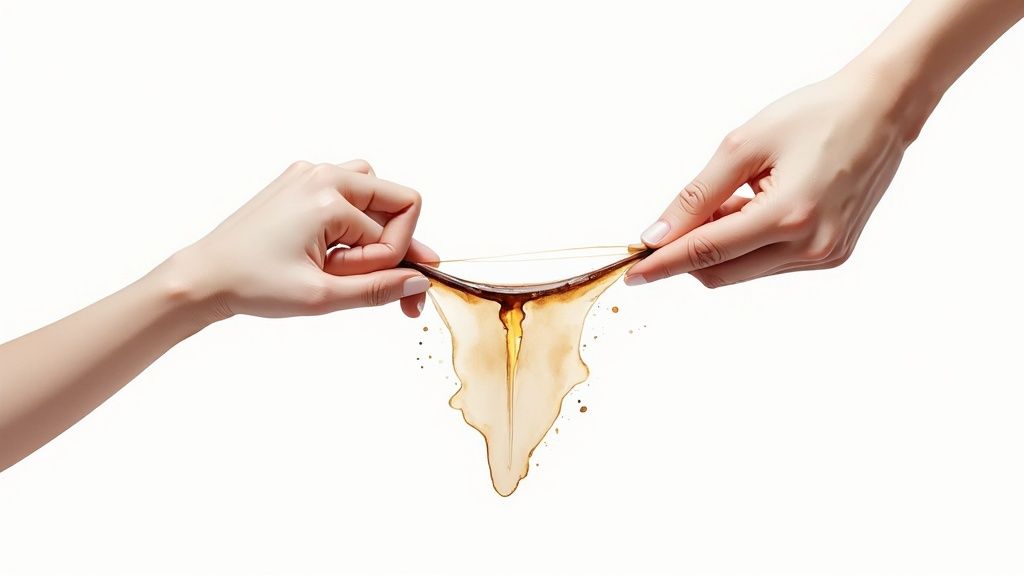
When you have high porosity hair, your game plan is all about a one-two punch: get moisture in, then seal it shut. Fast. Because the cuticles on your hair strands are raised and open, they drink up water and products like a sponge. The problem? They lose it all just as quickly, leaving you in a frustrating cycle of dryness, frizz, and breakage.
The best way to win this battle is by strategically layering your products. You're essentially building a tiny raincoat around each strand of hair. This is why you'll often hear people with high porosity hair swear by methods like LOC (Liquid-Oil-Cream) or its cousin, LCO (Liquid-Cream-Oil).
These aren't just trendy acronyms; they're a roadmap for application. You start with a water-based liquid for hydration, follow up with a cream to condition, and then lock it all down with an oil. This simple sequence makes a world of difference in keeping your hair moisturized for days, not hours.
The Critical Role of Protein and Sealing
High porosity hair often has a "battle-worn" cuticle layer with gaps and tears from things like coloring, heat styling, or even just the environment. This structural damage is exactly why it can feel weak, snap easily, and refuse to hold onto moisture. Protein treatments are your best friend here.
Think of protein like spackle for your hair. Ingredients like keratin and collagen temporarily fill in those gaps, reinforcing the hair's structure from the inside out. The result is better elasticity and hair that feels much stronger. Getting a protein-rich mask into your rotation every few weeks isn't just a good idea—it's essential.
Key Insight: For high porosity hair, moisture without a seal is temporary. Your routine is only as effective as your final sealing step. Heavy oils and butters aren't just for adding softness—they are functional ingredients that physically block moisture from escaping the hair shaft.
After you’ve hydrated and strengthened your hair, that final sealing step is non-negotiable. This is where richer oils like castor or jojoba and butters like shea come into play. They create a physical barrier over those raised cuticles, smoothing them down and trapping all that good moisture inside.
A Sample High Porosity Regimen
Consistency is everything. Your goal isn't just a great wash day; it's to keep your hair happy and hydrated all week long.
- Wash Day (1-2 times per week): Start with a gentle, sulfate-free shampoo that won't strip your hair. Follow it with a rich deep conditioner and let it sit for a good 20-30 minutes; wrapping your hair in a warm towel will help it absorb even better. Once rinsed, layer on a leave-in conditioner, a moisturizing styling cream, and finish with a sealing oil.
- Mid-Week Refresh: Don't be surprised if your hair feels thirsty a few days after washing. A light mist of water or a leave-in spray, followed by a small amount of oil or cream on your ends, can bring it right back to life.
- Protein Treatment (Every 2-4 weeks): Swap your deep conditioner for a protein mask. Pay attention to how your hair feels. If it feels overly soft or "mushy," it's begging for protein. If it starts to feel stiff or brittle, you might be overdoing it and can scale back. For a deep dive into restorative treatments, you can find excellent options in our guide to the best damaged hair masks.
Simple Tips for Maximum Impact
Beyond the products you use, a few small tweaks to your habits can make a huge difference in taming frizz and improving your hair’s health for good.
- Rinse with Cool Water: After conditioning, a quick rinse with cool (not cold!) water helps encourage the cuticle layer to lie flat. This simple step locks in moisture, reduces frizz, and boosts shine.
- Minimize Heat Styling: High porosity hair is already in a fragile state. Try to air-dry when you can, and if you must use heat, always, always use a quality heat protectant.
- Use Protective Styles: Buns, braids, and twists are more than just a style—they protect your delicate ends from friction, snagging, and environmental damage. This helps a lot with retaining both moisture and length.
- Sleep on Silk or Satin: Cotton pillowcases can suck moisture right out of your hair and cause friction that leads to breakage. A satin pillowcase or bonnet is a simple overnight fix that preserves your style and your hair's health.
Decoding Ingredients for Your Porosity Type
Walking down the hair care aisle can feel like a pop quiz you didn't study for. But once you know what your hair needs, reading an ingredient label becomes much easier. The whole game of low vs high porosity comes down to one thing: low porosity hair needs lightweight moisture that can actually get inside, while high porosity hair needs richer ingredients to fill in the gaps and seal the deal.
Think of it like this: your product's ingredient list is a recipe. For low porosity hair, you're on the hunt for ingredients with smaller molecules that won't just sit on top. For high porosity, you need things that can patch up the cuticle and create a protective seal.
Ingredients for Low Porosity Hair
Having low porosity hair means your hair's cuticle layer is packed down tight, making it tough for moisture to get in. The goal is to find ingredients that can sneak past the guard at the gate, rather than just causing a traffic jam of buildup on the surface.
Lightweight hydrators and oils are going to be your absolute best friends. Keep an eye out for these:
- Humectants: These are moisture magnets. Ingredients like glycerin, aloe vera, and honey are brilliant because they pull water from the air right into your hair shaft.
- Lightweight Oils: Not all oils are created equal. You need ones with smaller molecules that can penetrate that tight cuticle. Look for argan oil, grapeseed oil, jojoba oil, and almond oil. They give you that beautiful moisture and shine without the greasy, weighed-down feeling.
On the flip side, you'll want to be cautious with heavy butters like shea and cocoa butter. The same goes for thick, dense oils like castor and coconut oil, at least in large amounts. Their molecules are often just too big to get in, leading straight to that dreaded product buildup.
Ingredients for High Porosity Hair
High porosity hair is the opposite—it's got an open-door policy. Moisture gets in easily, but it leaves just as quickly. Your ingredient strategy should be all about strengthening, hydrating, and—most importantly—sealing that cuticle shut.
Scan the labels for products that are packed with these powerhouses:
- Proteins: Think of ingredients like hydrolyzed keratin, silk protein, and collagen as hair spackle. They temporarily fill in the gaps and tears in a damaged cuticle, which restores strength and bounce.
- Rich Butters and Creams: This is where the heavy hitters shine. Shea butter and mango butter are incredible for delivering deep moisture and helping to smooth down that rough, open cuticle.
- Sealing Oils: You need heavier oils to lock in all that good moisture and protein. Castor oil, olive oil, and avocado oil are perfect for creating a protective film that stops water from escaping.
The topic of silicones often comes up here. While some can cause issues, others offer amazing slip and sealing power that high porosity hair desperately needs. To make the right call for your hair, you have to get the full picture. You can dive deeper into this with our guide on whether silicones ruin your hair.
The Savvy Shopper Rule: For low porosity, if a product feels thick and heavy in your hand, it's going to feel heavy on your hair. For high porosity, those rich, creamy textures are your secret weapon against frizz and chronic dryness.
Your Hair Porosity Questions, Answered
Once you start digging into the world of low vs. high porosity hair, a lot of questions tend to pop up. Let's clear up some of the most common ones so you can build a routine that actually gets you results.
Can My Hair Porosity Change Over Time?
Absolutely. While your genetic makeup gives you a starting point for your hair's porosity, it's definitely not permanent. Life happens, and your hair changes right along with it.
Things that can really rough up the cuticle—like bleaching, coloring, constant flat ironing, or even just a lot of sun—will cause it to lift. Over time, this kind of damage can turn what was once low porosity hair into high porosity hair. That's why it's a good idea to re-test your hair's porosity every few months, especially if you feel like your go-to products suddenly aren't working anymore.
What Is Medium Porosity Hair?
Think of medium porosity hair as the "sweet spot." It's often called the low-maintenance type because it has the best of both worlds. The cuticle layer is just loose enough to let moisture in easily, but not so open that it escapes right away.
The best way to care for it is with a balanced routine.
- It doesn't need the heavy-duty sealing that high porosity hair craves.
- It isn't as picky about lightweight products as low porosity hair is.
- A good deep conditioning treatment every so often is usually all it takes to keep it happy.
One thing to watch out for with medium porosity hair: don't go overboard on protein. A little can be great, but too much can make it feel stiff and brittle, just like it would with low porosity hair.
Why Do Heavy Products Just Sit On My Hair?
This is the classic sign of low porosity hair. If you feel like rich butters and thick oils just create a greasy film on your strands, you're not imagining it. It all comes down to the simple physics of your hair's structure.
Low porosity hair has a cuticle layer that is packed down incredibly tight, like shingles on a roof. The molecules in ingredients like shea butter or castor oil are just too large to squeeze through that barrier. Instead of soaking in, they just sit on top, leading to that weighed-down, product-heavy feeling. This is exactly why water-based, lightweight formulas are your best friend.
Ready to give your hair exactly what it needs? Explore the targeted, salon-quality solutions from Morfose and build the perfect hair care routine for your porosity type today. Discover the collection at https://themorfose.com.

